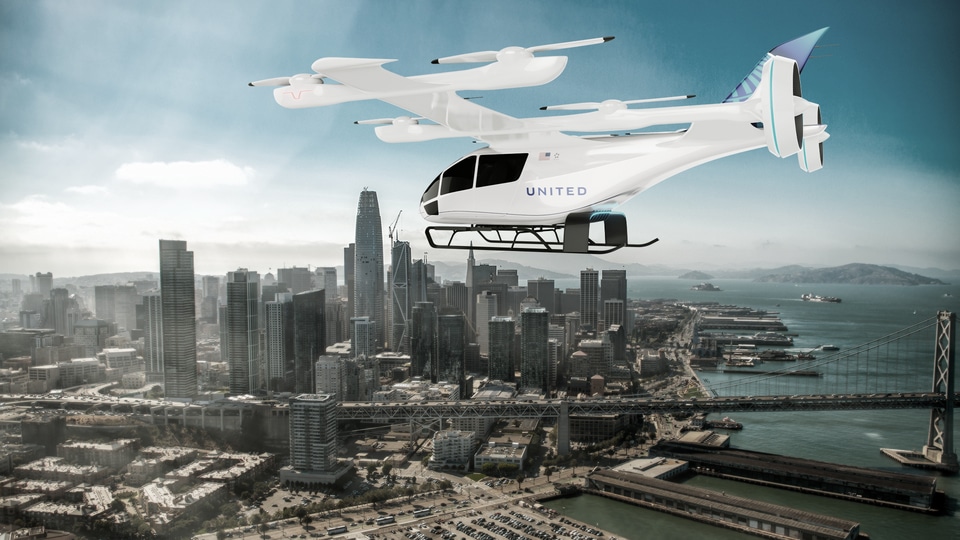Aerospace
United Airlines and Eve Air Mobility announce eVTOL aircraft service in San Francisco

Today, Eve Air Mobility and United Airlines revealed their plans to start electric commuter flights all across the Bay Area, bringing Urban Air Mobility to San Francisco. The announcement is a crucial first step since both businesses will collaborate with local and state government representatives, infrastructure, energy, and technology providers to guarantee the necessary infrastructure is put in place for the introduction of electric vertical takeoff and landing (eVTOL) aircraft flights.
Urban Air Mobility’s origin and destination locations as well as the future route network are also being determined by the corporations.
BLADE India signs a purchase order for up to 200 of Eve’s eVTOL(Opens in a new browser tab)
Compared to conventional air taxis and other traditional public transit options, Eve’s eVTOL will give United’s clients a speedy, affordable, and low-carbon means to commute in crowded urban areas. The San Francisco Bay Area can use Eve’s 100% electric eVTOL to fulfill a range of urban air transportation operations with its 60-mile (100-kilometer) range. Through a human-centered design that minimizes noise, it better ensures the comfort of travelers, the pilot, and the surrounding community.
With specialized rotors for vertical flight and fixed wings for cruising, the aircraft has a lift + cruise layout, which eliminates the need for moving parts during flight. At first, it will be piloted, but as it develops, it will operate without a crew.
Eve pointed out that eVTOL flights in the Bay Area are anticipated to have a good economic impact on the community, including new employment prospects, in addition to providing a new, efficient mode of transportation. The introduction and growth of eVTOL flights will necessitate a wide variety of positions, from pilots and aircraft service specialists to training and technical services.
The community is also anticipated to gain value and employment possibilities from the development of the necessary infrastructure to enable eVTOL operations. In 2026, Eve’s eVTOL is expected to go into operation.

Aerospace
Boeing Transfers Rocket Stage to NASA, Paving Way for Human Moon Mission

Boeing has achieved a significant milestone by providing NASA with the second core stage of the Space Launch System (SLS) rocket.
This crucial component, crafted at NASA’s Michoud Assembly Facility (MAF), is set to propel the Artemis II crew into lunar orbit, marking humanity’s return to deep space after a 50-year hiatus.
The monumental Boeing-built rocket stage, the largest element of the Artemis II mission, will embark on a journey aboard the Pegasus barge, traveling 900 miles to NASA’s Kennedy Space Center.
Comparison of two legendary aircraft B777x vs B747 aircraft:Click here
Upon arrival, it will be meticulously integrated with other essential Artemis II components, including the upper stage, solid rocket boosters, and NASA’s Orion spacecraft within the iconic Vehicle Assembly Building. This intricate integration process is a vital step toward the eagerly anticipated Artemis II launch, slated for 2025.
“Boeing-built products helped land humankind on the moon in 1969, and we’re proud to continue that legacy through the Artemis generation,” remarked Dave Dutcher, vice president and program manager for Boeing’s SLS program. “Together, with NASA and our industry partners and suppliers, we are building the world’s most capable rocket and paving the way to deep space through America’s rocket factory in New Orleans.”
NASA, Lockheed Martin Reveal X-59 Quiet Supersonic Aircraft:Click here
The delivery of Core Stage 2 marks a significant achievement in the evolution of the SLS rocket. Towering over 200 feet and powered by four RS-25 engines, this core stage, coupled with two solid-fueled booster rockets, will generate a staggering 8.8 million pounds of thrust. This immense power is crucial to launching Artemis II and future missions into the vast expanse of space.
The SLS rocket stands unparalleled in its capability to transport both crew and substantial cargo to the moon and beyond in a single launch. Its extraordinary capacity will facilitate the delivery of human-rated spacecraft, habitats, and scientific missions to destinations including the moon and Mars, ushering in a new era of space exploration.
-

 Travel1 week ago
Travel1 week agoAir India to Expand US Operations with Three New Routes After a Decade
-

 Travel2 weeks ago
Travel2 weeks agoWhy We Should Avoid These Stamps in a Passport
-

 Airlines1 month ago
Airlines1 month agoInvestigations Reveal Fake Chinese Titanium in Boeing and Airbus Jets
-

 Tech4 weeks ago
Tech4 weeks agoChina’s CATL Plans 1,800-Mile Electric Plane Launch by 2027
-

 Airport3 days ago
Airport3 days agoTop 10 Largest Airports in the World by Size
-

 Aerospace4 weeks ago
Aerospace4 weeks agoChina’s Fighter Jets Turn Wings into Autonomous Drones
-

 Airlines4 days ago
Airlines4 days agoAir India Rolls Out A350s for Delhi-New York JFK and Newark Routes
-

 Defence3 weeks ago
Defence3 weeks agoBoeing Enhances Chinook with New Engines and Block II Upgrades at $96 Million







